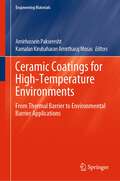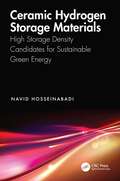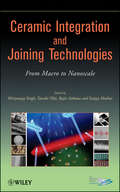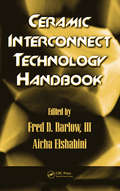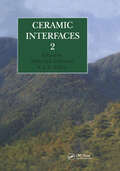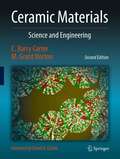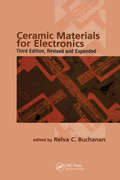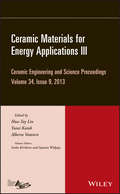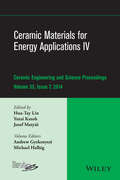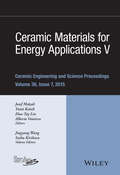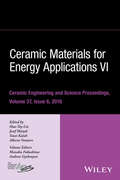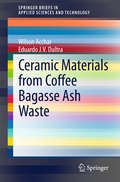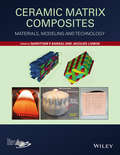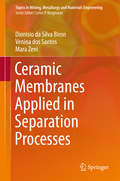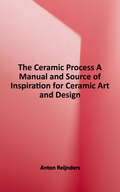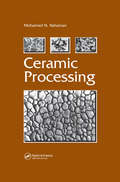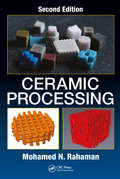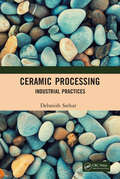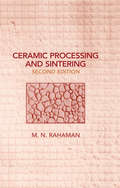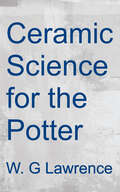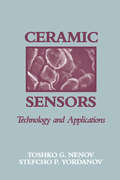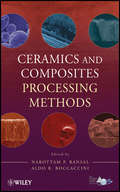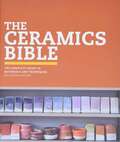- Table View
- List View
Ceramic Coatings for High-Temperature Environments: From Thermal Barrier to Environmental Barrier Applications (Engineering Materials)
by Amirhossein Pakseresht Kamalan Kirubaharan Amirtharaj MosasThis book addresses the recent trends in thermal and environmental barrier coatings and their applications in extreme environments. It introduces the state of the art in coating materials and processes for high and ultrahigh-temperature environments and identifies areas for improvement in materials selection, performance upgrades, design considerations, and manufacturing methods. This book also covers fundamental studies involving modelling, creating coating architectures, coating preparation methods, and coating capability throughout a wide temperature range. The book examines a variety of high-temperature coatings prepared through various synthesis processes such as thermal spraying, electron beam evaporation, and sol–gel methods. This book also covers ultrahigh-temperature ceramic (UHTC) materials and provides a brief overview of the synthesis method, densification processes, and coating methods along with the properties and applications of emerging high entropy UHTCs. With contributions from international researchers active in the field, this edited book features the most recent and up-to-date literature references for a broad readership consisting of academic and industrial professionals. It is suitable for graduate students as well as materials scientists and engineers working in the area of high and ultrahigh-temperature ceramic materials.
Ceramic Hydrogen Storage Materials: High Storage Density Candidates for Sustainable Green Energy
by null Navid HosseinabadiCeramic Hydrogen Storage Materials presents the physical, chemical, physico-chemical properties of ceramics as hydrogen storage materials. It demonstrates how ceramic nanostructures can be specifically designed for high surface adsorption of hydrogen and can function as hydrogen batteries.Covering methods for characterizing hydrogen storage capacity, this book showcases how hydrogen has the potential to facilitate decarbonization of the electric power sector by storing energy produced from renewable sources. It addresses both ceramic oxides and non-oxides while expanding on the synthesis and characterization of zero- and one-dimensional, high-surface-area ceramic structures. This book discusses the applications of hydrogen batteries in zero-emission vehicles and hydrogen fuels for aircraft.This book will interest upper-level undergraduate energy and materials engineering students, as well as researchers studying green energy storage materials, hydrogen storage, and alternative transportation fuels.
Ceramic Integration and Joining Technologies
by Rajiv Asthana Sanjay Mathur Mrityunjay Singh Tatsuki OhjiThis book joins and integrates ceramics and ceramic-based materials in various sectors of technology. A major imperative is to extract scientific information on joining and integration response of real, as well as model, material systems currently in a developmental stage.This book envisions integration in its broadest sense as a fundamental enabling technology at multiple length scales that span the macro, millimeter, micrometer and nanometer ranges. Consequently, the book addresses integration issues in such diverse areas as space power and propulsion, thermoelectric power generation, solar energy, micro-electro-mechanical systems (MEMS), solid oxide fuel cells (SOFC), multi-chip modules, prosthetic devices, and implanted biosensors and stimulators. The engineering challenge of designing and manufacturing complex structural, functional, and smart components and devices for the above applications from smaller, geometrically simpler units requires innovative development of new integration technology and skillful adaptation of existing technology.
Ceramic Interconnect Technology Handbook
by Fred D. Barlow and Aicha ElshabiniCeramics were among the first materials used as substrates for mass-produced electronics, and they remain an important class of packaging and interconnect material today. Most available information about ceramic electronics is either outdated or focused on their materials science characteristics. The Ceramic Interconnect Technology Handbook goes beyond the traditional approach by first surveying the unique properties of ceramics and then discussing design, processing, fabrication, and integration, as well as packaging and interconnect technologies.Collecting contributions from an outstanding panel of experts, this book offers an up-to-date overview of modern ceramic electronics, from design and material selection to manufacturing and implementation. Beginning with an overview of the development, properties, advantages, and applications of ceramics, coverage spans electrical design, testing, simulation, thermomechanical design, screen printing, multilayer ceramics, photo-defined and photo-imaged films, copper interconnects for ceramic substrates, and integrated passive devices in ceramic substrates. It also offers a detailed review of the surface, thermal, mechanical, and electrical properties of various ceramics as well as the processing of high- and low-temperature cofired ceramic (HTCC and LTCC) substrates.Opening new vistas and avenues of advancement, the Ceramic Interconnect Technology Handbook is the only source for comprehensive discussion and analysis of nearly every facet of ceramic interconnect technology and applications.
Ceramic Interfaces 2
by Kim Ill YooThe science of ceramic interfaces is multidisciplinary, overlapping several existing, well-established disciplines such as solid-state chemistry, high-temperature chemistry, solid-state electrochemistry, surface science, catalysis and metallurgy. This volume contains the processing’s of the 4th international workshop on ceramic Interfaces held at the Korea Advanced Institute of Science and Technology, Taejon, Korea. 27 specialists from 8 countries contributed of the workshop which was divided into 3 sessions: Microstructural development; Transport; Interfacial Phenomena and Kinetics.
Ceramic Lasers
by Akio Ikesue Yan Lin Aung Voicu Lupei Akio Ikesue Yan Lin Aung Voicu LupeiUntil recently, ceramic materials were considered unsuitable for optics due to the numerous scattering sources, such as grain boundaries and residual pores. However, in the 1990s the technology to generate a coherent beam from ceramic materials was developed, and a highly efficient laser oscillation was realized. In the future, the technology derived from the development of the ceramic laser could be used to develop new functional passive and active optics. Co-authored by one of the pioneers of this field, the book describes the fabrication technology and theoretical characterization of ceramic material properties. It describes novel types of solid lasers and other optics using ceramic materials to demonstrate the application of ceramic gain media in the generation of coherent beams and light amplification. This is an invaluable guide for physicists, materials scientists and engineers working on laser ceramics.
Ceramic Materials: Science and Engineering
by C. Barry Carter M. Grant NortonCeramic Materials: Science and Engineering is an up-to-date treatment of ceramic science, engineering, and applications in a single, comprehensive text. Building on a foundation of crystal structures, phase equilibria, defects, and the mechanical properties of ceramic materials, students are shown how these materials are processed for a wide diversity of applications in today's society. Concepts such as how and why ions move, how ceramics interact with light and magnetic fields, and how they respond to temperature changes are discussed in the context of their applications. References to the art and history of ceramics are included throughout the text, and a chapter is devoted to ceramics as gemstones. This course-tested text now includes expanded chapters on the role of ceramics in industry and their impact on the environment as well as a chapter devoted to applications of ceramic materials in clean energy technologies. Also new are expanded sets of text-specific homework problems and other resources for instructors. The revised and updated Second Edition is further enhanced with color illustrations throughout the text.
Ceramic Materials for Electronics
by Relva C. BuchananThe Third Edition of Ceramic Materials for Electronics studies a wide range of ceramic materials, including insulators, conductors, piezoelectrics, and ferroelectrics, through detailed discussion of their properties, characterization, fabrication, and applications in electronics. The author summarizes the latest trends and advancements in the field, and explores important topics such as ceramic thin film, functional device technology, and thick film technology. Edited by a leading expert on the subject, this new edition includes more than 150 pages of new information; restructured reference materials, figures, and tables; as well as additional device application-oriented segments.
Ceramic Materials for Energy Applications III: Ceramic Engineering and Science Proceedings, Volume 34 Issue 9
by Yutai Katoh Hua-Tay Lin Alberto Vomiero Soshu Kirihara Sujanto WidjajaCeramic Engineering and Science Proceedings Volume 34, Issue 9 - Ceramic Materials for Energy Applications III A collection of 15 papers from The American Ceramic Society's 37th International Conference on Advanced Ceramics and Composites, held in Daytona Beach, Florida, January 27-February 1, 2013. This issue includes papers presented in Symposia 6 -Advanced Materials and Technologies for Rechargeable Energy Storage; Symposium13 - Advanced Ceramics and Composites for Sustainable Nuclear Energy and FusionEnergy; Focused Session 4 - Advanced Processing for Photonics and Energy; andthe Engineering Summit of the Americas session.
Ceramic Materials for Energy Applications IV: Ceramic Engineering and Science Proceedings, Volume 35 Issue 7
by Michael Halbig Yutai Katoh Josef Matyas Andrew L. Gyekenyesi Hua-Tay LinA collection of 14 papers from The American Ceramic Society's 38th International Conference on Advanced Ceramics and Composites, held in Daytona Beach, Florida, January 26-31, 2014. This issue includes papers presented in Symposia 6 - Advanced Materials and Technologies for Energy Generation, Conversion, and Rechargeable Energy Storage and Symposium 13 - Advanced Ceramics and Composites for Sustainable Nuclear Energy and Fusion Energy.
Ceramic Materials for Energy Applications V: Ceramic Engineering and Science Proceedings, Volume 36 Issue 7
by Hua-Tay Lin Josef Matyas Yutai Katoh Alberto Vomiero Soshu Kirihara Jingyang WangThe Ceramic Engineering and Science Proceeding has been published by The American Ceramic Society since 1980. This series contains a collection of papers dealing with issues in both traditional ceramics (i. e. , glass, whitewares, refractories, and porcelain enamel) and advanced ceramics. Topics covered in the area of advanced ceramic include bioceramics, nanomaterials, composites, solid oxide fuel cells, mechanical properties and structural design, advanced ceramic coatings, ceramic armor, porous ceramics, and more.
Ceramic Materials for Energy Applications VI
by Alberto Vomiero Andrew Gyekenyesi Hua-Tay Lin Manabu Fukushima Yutai Katoh Josef MatyášA collection of 15 papers from The American Ceramic Society’s 40th International Conference on Advanced Ceramics and Composites, held in Daytona Beach, Florida, January 24-29, 2016. This issue includes papers presented in Symposia 6 - Advanced Materials and Technologies for Energy Generation, Conversion, and Rechargeable Energy Storage; Symposium 13 - Advanced Ceramics and Composites for Sustainable Nuclear Energy and Fusion Energy, and Focused Session 2 – Advanced Ceramic Materials and Processing for Photonics and Energy.
Ceramic Materials from Coffee Bagasse Ash Waste (SpringerBriefs in Applied Sciences and Technology)
by Wilson Acchar Eduardo J. V. DultraThis book proposes the use of coffee bagasse ash (CBA) waste as raw material to be used in ceramic formulations. The approach presented here is a solution to a current ambiental problem as CBA waste is discharged in high amounts in agriculture. The authors analyze the potencial of CBA as a material to substitute feldspar in tile production.
Ceramic Matrix Composites
by Jacques Lamon Narottam P. BansalThis book is a comprehensive source of information on various aspects of ceramic matrix composites (CMC). It covers ceramic and carbon fibers; the fiber-matrix interface; processing, properties and industrial applications of various CMC systems; architecture, mechanical behavior at room and elevated temperatures, environmental effects and protective coatings, foreign object damage, modeling, life prediction, integration and joining. Each chapter in the book is written by specialists and internationally renowned researchers in the field. This book will provide state-of-the-art information on different aspects of CMCs. The book will be directed to researchers working in industry, academia, and national laboratories with interest and professional competence on CMCs. The book will also be useful to senior year and graduate students pursuing degrees in ceramic science and engineering, materials science and engineering, aeronautical, mechanical, and civil or aerospace engineering.Presents recent advances, new approaches and discusses new issues in the field, such as foreign object damage, life predictions, multiscale modeling based on probabilistic approaches, etc.Caters to the increasing interest in the application of ceramic matrix composites (CMC) materials in areas as diverse as aerospace, transport, energy, nuclear, and environment. CMCs are considered ans enabling technology for advanced aeropropulsion, space propulsion, space power, aerospace vehicles, space structures, as well as nuclear and chemical industries.Offers detailed descriptions of ceramic and carbon fibers; fiber-matrix interface; processing, properties and industrial applications of various CMC systems; architecture, mechanical behavior at room and elevated temperatures, environmental effects and protective coatings, foreign object damage, modeling, life prediction, integration/joining.
Ceramic Membranes Applied in Separation Processes
by Dionisio da Silva Biron Venina Dos Santos Mara ZeniThis book covers diverse types of ceramic membranes applied in separation processes. The authors present the preparation methods and well as the main application of ceramic membranes. Modules, microfiltration and ultrafiltration are topics described within the text. The final chapter focuses on water and wastewater treatment by membranes separation processes.
The Ceramic Process: A Manual and Source of Inspiration for Ceramic Art and Design
by Anton Reijnders European Ceramic Work CentreThe European Ceramic Work Centre (EKWC) is an international studio dedicated to the ceramic arts, in all of their various forms. Drawn from the resources at the EKWC, this volume elucidates every aspect of the ceramic process, from wedging clay to packing kilns. This useful resource will be valuable to potters of every skill level. Extensively and vividly illustrated, the book demonstrates complicated techniques visually. In addition to the helpful diagrams, works produced at EKWC are used as examples of the methods described in the text, offering specific uses for procedures. The process is integral to every clay piece, and this volume follows the logic of the steps of creation. The beginning chapters explain the early steps such as clay preparation and the various techniques of making. Following chapters are devoted to the later steps of drying and firing. Also included are numerous glaze and clay recipes, using a range of widely available materials. Complex and large-scale work, always demanding special attention and specialized knowledge, is comprehensively covered.
Ceramic Processing
by Mohamed N. RahamanMaterials scientists continue to develop stronger, more versatile ceramics for advanced technological applications, such as electronic components, fuel cells, engines, sensors, catalysts, superconductors, and space shuttles. From the start of the fabrication process to the final fabricated microstructure, Ceramic Processing covers all aspects of modern processing for polycrystalline ceramics. Stemming from chapters in the author's bestselling text, Ceramic Processing and Sintering, this book gathers additional information selected from many sources and review articles in a single, well-researched resource. The author outlines the most commonly employed ceramic fabrication processes by the consolidation and sintering of powders. A systematic approach highlights the importance of each step as well as the interconnection between the various steps in the overall fabrication route. The in-depth treatment of production methods includes powder, colloidal, and sol-gel processing as well as chemical synthesis of powders, forming, sintering, and microstructure control. The book covers powder preparation and characterization, organic additives in ceramic processing, mixing and packing of particles, drying, and debinding. It also describes recent technologies such as the synthesis of nanoscale powders and solid freeform fabrication. Ceramic Processing provides a thorough foundation and reference in the production of ceramic materials for advanced undergraduates and graduate students as well as professionals in corporate training or professional courses.
Ceramic Processing
by Mohamed N. RahamanMany of the properties critical to the engineering applications of ceramics are strongly dependent on their microstructure which, in turn, is dependent on the processing methods used to produce the ceramic material. Ceramic Processing, Second Edition provides a comprehensive treatment of the principles and practical methods used in producing ceramics with controlled microstructure. Covering the main steps in the production of ceramics from powders, the book also provides succinct coverage of other methods for fabricating ceramics, such as sol−gel processing, reaction bonding, chemical vapor deposition and polymer pyrolysis. While maintaining the objectives of the successful first edition, this new edition has been revised and updated to include recent developments and expanded to feature new chapters on additives used in ceramic processing; rheological properties of suspensions, slurries, and pastes; granulation, mixing, and packing of particles; and sintering theory and principles. Intended as a textbook for undergraduate and graduate courses in ceramic processing, the book also provides an indispensable resource for research and development engineers in industry who are involved in the production of ceramics or who would like to develop a background in the processing of ceramics.
Ceramic Processing: Industrial Practices
by Debasish SarkarThis book gives a comprehensive account on the manufacturing techniques to synchronize the desired properties of both traditional and advanced ceramics. Offers exclusive and up to date information on industrial ceramic processing equipment and approaches and discusses actual industrial practices taking a product-oriented approach It should serve as a text to answer the processing of ceramics and achieve targeted product in industrial environment.
Ceramic Processing and Sintering (Materials Engineering #Vol. 23)
by Mohamed N. RahamanAs the field's premiere source, this reference is extensively revised and expanded to collect hard-to-find applications, equations, derivations, and examples illustrating the latest developments in ceramic processing technology. This book is concerned primarily with the processing of polycrystalline ceramics and focuses on the widespread fabrication of ceramics by the firing of consolidated powders forms. A brief treatment of sol-gel processing is also included.Ceramic Processing and Sintering, Second Edition provides clear and intensive discussions on colloidal and sol-gel processing, sintering of ceramics, and kinetic processes in materials. From powder synthesis and consolidation to sintering and densification behavior, this latest edition emphasizes the impact of each processing procedure on ceramic properties. The second edition also contains new and extended discussions on colloid stability, polymer growth and gelation, additives in ceramic forming, diffusion and defect strucutre, normal and abnormal grain growth, microwave sintering, Rayleigh instability effects, and Ostwald ripening. Illustrating the interconnectedness between the various steps in the overall fabrication route, Ceramic Processing and Sintering, Second Edition approaches the fundamental issues of each process and show how they are applied to the practical fabrication of ceramics.
Ceramic Science For The Potter (Creative Crafts Ser.)
by W. G. LawrenceThe ceramic artist, potter or designer makes use of materials to create a useful and appealing object. In this creative effort he uses many types of materials, often with little background knowledge as to how they may be¬have. Unexpected or disappointing results may ultimately be corrected on a trial and error basis but usually at too great a cost in time and jangled nerves. For those who have made such mistakes and who wish to understand their materials more thoroughly, this book will be useful.
Ceramic Sensors: Technology and Applications
by Toshko Nenov Stefcho P. YordanovFrom the Author's PrefaceCeramic sensors have been in use for more than thirty years. Since ceramics exhibit a number of specific characteristics that enable their cost to become lower and their reliability to increase, they have occupied a significant position in sensor technology. This is why many companies and universities have directed their efforts towards investigating and developing new ceramic sensors and expanding their areas of application.To the best of our knowledge.., there [has been] no book treating different sensors on the basis of their common physical and chemical properties, technological principles, and applications. This book [is] a detailed survey of ceramic sensors and a generalization of the results achieved in this field so far. Ceramic sensors for different physical quantities are discussed without going too deep into theory...The concept of ceramic sensors includes all sensors that are produced using ceramic technology. It also covers thick film sensors, since from a structural and technological point of view, they can be regarded as a variety of ceramic sensors. The subject of scientific research in this book is humidity, gas. temperature, and pressure sensors on the basis of semiconductor and dielectric ceramic materials and solid electrolytes.Special attention is paid to the physical and chemical, as well as the technological, bases of ceramic sensors, their classification, the types of materials used... , the methods of controlling their parameters and characteristics, the areas of application, and the electric circuits for connecting the sensors.
Ceramics and Composites Processing Methods
by Narottam P. Bansal Aldo R. BoccacciniExamines the latest processing and fabrication methodsThere is increasing interest in the application of advanced ceramic materials in diverse areas such as transportation, energy, environmental protection and remediation, communications, health, and aerospace. This book guides readers through a broad selection of key processing techniques for ceramics and their composites, enabling them to manufacture ceramic products and components with the properties needed for various industrial applications. With chapters contributed by internationally recognized experts in the field of ceramics, the book includes traditional fabrication routes as well as new and emerging approaches in order to meet the increasing demand for more reliable ceramic materials.Ceramics and Composites Processing Methods is divided into three sections:Densification, covering the fundamentals and practice of sintering, pulsed electric current sintering, and viscous phase silicate processingChemical Methods, examining colloidal methods, sol-gel, gel casting, polymer processing, chemical vapor deposition, chemical vapor infiltration, reactive melt infiltration, and combustion synthesisPhysical Methods, including directional solidification, solid free-form fabrication, microwave processing, electrophoretic deposition, and plasma sprayingEach chapter focuses on a particular processing method or approach. Collectively, these chapters offer readers comprehensive, state-of-the-science information on the many approaches, techniques, and methods for the processing and fabrication of advanced ceramics and ceramic composites.With its coverage of the latest processing methods, Ceramics and Composites Processing Methods is recommended for researchers and students in ceramics, materials science, structural materials, biomedical engineering, and nanotechnology.
The Ceramics Bible: The Complete Guide to Materials and Techniques (Ceramics Book, Ceramics Tools Book, Ceramics Kit Book)
by Louisa TaylorCeramicists have been plying their art and craft for thousands of years, and never more prolifically than today. The Ceramics Bible is the most comprehensive and up-to-date volume on the subject. Brimming with more than 700 full-color photos and illustrations, this is the new definitive guide for serious ceramics practitioners. <p><p>Inside are step-by-step instructions on molding, firing, and glazing techniques, generously accompanied by detailed photographs. Also included are beautiful examples of contemporary work, plus plenty of historical information, artist profiles, troubleshooting tips, and an extensive resource section. Perfect for students, artists, and collectors, this is a tremendously valuable addition to the vibrant world of ceramics.
Ceramics for Energy Conversion, Storage, and Distribution Systems: Ceramic Transactions, Volume 255
by Tatsuki Ohji Alexander Michaelis Dileep Singh John Wei Mrityunjay Singh Thomas Pfeifer Palani Balaya Josef MatyásA collection of 25 papers presented at the 11th International Symposium on Ceramic Materials and Components for Energy and Environmental Applications (CMCEE-11), June 14-19, 2015 in Vancouver, BC, Canada. Paper in this volume were presented in the below six symposia from Track 1 on the topic of Ceramics for Energy Conversion, Storage, and Distribution Systems: High-Temperature Fuel Cells and Electrolysis Ceramic-Related Materials, Devices, and Processing for Heat-to-Electricity Direct Conversion Material Science and Technologies for Advanced Nuclear Fission and Fusion Energy Advanced Batteries and Supercapacitors for Energy Storage Applications Materials for Solar Thermal Energy Conversion and Storage High Temperature Superconductors: Materials, Technologies, and Systems
